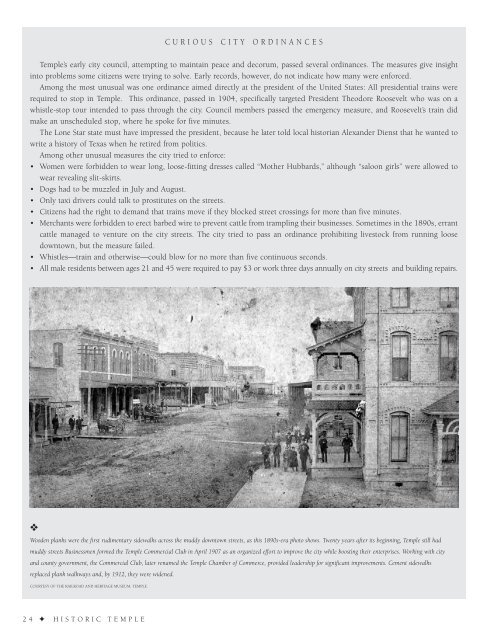Historic Temple
An illustrated history of the city of Temple, Texas, paired with the histories of companies, families and organizations that make the city great.
An illustrated history of the city of Temple, Texas, paired with the histories of companies, families and organizations that make the city great.
You also want an ePaper? Increase the reach of your titles
YUMPU automatically turns print PDFs into web optimized ePapers that Google loves.
CURIOUS CITY ORDINANCES<br />
<strong>Temple</strong>’s early city council, attempting to maintain peace and decorum, passed several ordinances. The measures give insight<br />
into problems some citizens were trying to solve. Early records, however, do not indicate how many were enforced.<br />
Among the most unusual was one ordinance aimed directly at the president of the United States: All presidential trains were<br />
required to stop in <strong>Temple</strong>. This ordinance, passed in 1904, specifically targeted President Theodore Roosevelt who was on a<br />
whistle-stop tour intended to pass through the city. Council members passed the emergency measure, and Roosevelt’s train did<br />
make an unscheduled stop, where he spoke for five minutes.<br />
The Lone Star state must have impressed the president, because he later told local historian Alexander Dienst that he wanted to<br />
write a history of Texas when he retired from politics.<br />
Among other unusual measures the city tried to enforce:<br />
• Women were forbidden to wear long, loose-fitting dresses called “Mother Hubbards,” although “saloon girls” were allowed to<br />
wear revealing slit-skirts.<br />
• Dogs had to be muzzled in July and August.<br />
• Only taxi drivers could talk to prostitutes on the streets.<br />
• Citizens had the right to demand that trains move if they blocked street crossings for more than five minutes.<br />
• Merchants were forbidden to erect barbed wire to prevent cattle from trampling their businesses. Sometimes in the 1890s, errant<br />
cattle managed to venture on the city streets. The city tried to pass an ordinance prohibiting livestock from running loose<br />
downtown, but the measure failed.<br />
• Whistles—train and otherwise—could blow for no more than five continuous seconds.<br />
• All male residents between ages 21 and 45 were required to pay $3 or work three days annually on city streets and building repairs.<br />
❖<br />
Wooden planks were the first rudimentary sidewalks across the muddy downtown streets, as this 1890s-era photo shows. Twenty years after its beginning, <strong>Temple</strong> still had<br />
muddy streets Businessmen formed the <strong>Temple</strong> Commercial Club in April 1907 as an organized effort to improve the city while boosting their enterprises. Working with city<br />
and county government, the Commercial Club, later renamed the <strong>Temple</strong> Chamber of Commerce, provided leadership for significant improvements. Cement sidewalks<br />
replaced plank walkways and, by 1912, they were widened.<br />
COURTESY OF THE RAILROAD AND HERITAGE MUSEUM, TEMPLE.<br />
24 ✦ HISTORIC TEMPLE
















